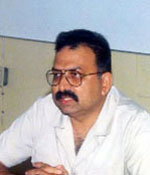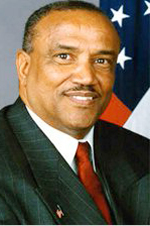Leaked embassy cables reveal…Interesting perspectives by US envoy on “Sash” Sawh killing
Two days after the shocking 2006 murder of former Minister of Fisheries, Satyadeow “Sash” Sawh, senior Guyanese functionaries had met the then United States Ambassador Roland Bullen asking for help to solve the case and recover more than 30-AK47s that went missing from the army.
According to recently released embassy cables from the whistleblower website, Wikileaks, the local US Embassy, headed by then Ambassador Roland Bullen, were examining at least three theories that led to the killing of the “jocular” Minister – one of the being a retaliation from a militant, Buxton –based group and two others that were linked with drugs.
The cables which were supposed to be confidential and sent by the local embassy to the US Secretary of State, also spoke of President’s Bharrat Jagdeo’s mood at the meeting.
According to the cables, Sawh was killed on April 22, and on April 24, Bullen met with Head of the Presidential Secretariat, Dr. Roger Luncheon, then later with President Jagdeo, to discuss the government of Guyana’s (GOG) request for security related assistance.
“Jagdeo and Luncheon essentially admitted that the public’s patience with the GOG’s performance on security is wearing thin, and they are looking for a response that “captures the public’s imagination”. The GOG has also asked Canada and the UK for help,” the cable dated May 4 said.
The cables were detailed.
“Jagdeo’s mood was somber, with a visibly furrowed brow. Minister Sawh’s killing has clearly hit senior GOG officials hard. Their psychological moat that made them feel separated and protected from Guyana’s security problem has vanished.”
The Ambassador, in the cable, said that according to Luncheon, Jagdeo has just about exhausted the Guyana security forces’ investigative capabilities and so they are forced to seek greater international assistance.
“Post’s impression is that Sawh’s killing has really woken up senior GOG politicos to the loss of state control over the country’s security.”
Dr. Luncheon, followed up with a written request for help, admitting that the government had
recognized that the assassination of Minister Sawh has created the gravest threat to the country’s democracy.
“Significantly, there are other threats associated with the existence of the criminal gang in Buxton and the intellectual authors of their crimes. Also the loss of the large number of AK-47 weapons from the military is still unexplained and recovery unrealised.”
Luncheon asked for assistance expanding investigations into the loss of the AK-47 weapons from the military, leading to the recovery, enhancing the Criminal Investigation Department’s investigation into the murder of Minister Sawh and his family, and for crime fighting equipment for an elite force.
The Ambassador also said that Minister of Home Affairs, Gail Teixeira; the Commissioner of Police, Winston Felix, and the Chief of Staff of the Guyana Defence Force, Brigadier Edward Collins, were consulted prior to dispatching this request.
“Rather, the request reflects what President Jagdeo, Luncheon and the Cabinet want during this moment of sorrow and possibly panic.”
Regarding the theories for the killing of Sawh, his sister, brother and security guard at the Minister’s LBI’s resident, the Embassy said it heard many stories about the motives.
In the first instance there was a political angle.
“A militant, presumably Afro-Guyanese anti-government faction wants to gain greater political power but feels it cannot do so through Guyana’s democratic process. The GOG is peddling this theory, and the GOG leadership is paranoid about a treasonous cadre of current and former military and police officers. This militant group is centered in Buxton, a coastal village approximately six miles east of Georgetown that is essentially beyond state control.”
The embassy at that time said it believed that a corollary to this theory is that Sawh was targeted in revenge for the January, 2006, killing of prominent Afro-Guyanese journalist and “rabble-rouser”, Ronald Waddell.
“To this end, the joint services have engaged in a series of searches of Buxton, which have netted night vision goggles, military uniforms, and other pieces of military equipment. Ballistics tests performed at spent shells from the Sawh murder scene prove that the same weapons were used in the February 26 Agricola/Eccles massacre and another gruesome shooting/beheading in Agricola in March 2005.”
According to Bullen, Luncheon, the government’s spokesman, might have fueled the political angle when he publicly mused in the April 27 post-Cabinet briefing that unspecified members of the PNCR have contacts with the bandits in Buxton.
“However, he explicitly stopped short of linking the PNCR to Sawh’s murder.”
“Another angle was that Sawh was involved in criminal activities. Sawh was said to be close with a suspected money launderer (named) and known alien smuggler who owns a fish farm “which appears to be a money laundering operation.”
The cable disclosed that this “money launderer” was previously arrested with several Guyanese and U.S. passports but later was acquitted of wrongdoing.
“As Minister responsible for fisheries, Sawh would have had an ostensible reason to meet with …(named).”
However, another theory was the Sawh was a “clean minister relative to many of his peers. Sawh took too strong a stand against criminal activity. Some are saying that Sawh took a lead role in urging the Cabinet not to issue forestry permits to suspect concerns, which pitted him against the drug lords.”
WikiLeaks, which released the secret cables, is an international non-profit organisation that publishes submissions of private, secret, and classified media from anonymous news sources, news leaks, and whistleblowers. Its website, launched in 2006 under The Sunshine Press organisation, claimed a database of more than 1.2 million documents within a year of its launch.
It has been highly controversial and raised the ire of several governments across the globe for the potentially embarrassing leaks.
Source:


